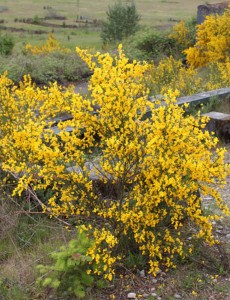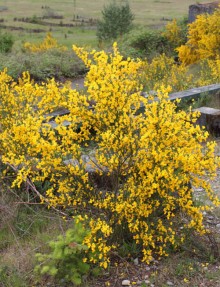— from Gwen Stamm —
 Scotch Broom (Cytisus scoparius) is an invasive, many-branched shrub with green stems and bright yellow flowers, typically blooming from April to June and visible to us all from county roads. It is classified as a Class B noxious weed in Washington State and control is required, because it is a serious fire hazard and is crowding out native and beneficial plants, causing loss of grasslands and degrading open space. Seeds are toxic to livestock and horses and can remain viable up to 80 years.
Scotch Broom (Cytisus scoparius) is an invasive, many-branched shrub with green stems and bright yellow flowers, typically blooming from April to June and visible to us all from county roads. It is classified as a Class B noxious weed in Washington State and control is required, because it is a serious fire hazard and is crowding out native and beneficial plants, causing loss of grasslands and degrading open space. Seeds are toxic to livestock and horses and can remain viable up to 80 years.
Now is a good time to remove Scotch Broom, before the pods mature to produce additional seeds. Broom is easily identified by its 5-angled stems, small deciduous leaves (each with three narrow leaflets), and, of course, by the bright yellow flowers, each about ¾-inch long with 5 petals. The similar looking shrub, gorse (Ulex europaeus) also is selected for control county-wide and is distinguished by round stems and prominent spines on mature stems instead of leaves.
Since one small foothold can infest an entire neighborhood, many of us volunteer to help our neighbors control infestations. There are several approaches for removal of Scotch Broom:
- Pull it out. For large brooms, we can borrow a Weed Wrench (free) from the County Noxious Weed Control Program at the Senior Center on Orcas, the Land Bank office on San Juan or Public Works on Lopez.
- Cut it back to the ground each year before it sets seed. It is important to act before the small pods mature, in late June. Cutting mature plants greater than 1 inch at the base has been shown to be the best technique to kill the plant as it minimizes soil disturbance, thus doing less damage to desirable plants and bringing fewer seeds to the surface where they germinate. Cutting is most effective when plants are stressed by summer drought and have had their energy sapped by flower production.
- Monitor for seedlings each spring and pull them up, roots and all, while they are small and the ground is still moist. Since Scotch broom seed lasts for years in the soil, we must continue to monitor to prevent reinvasion by new seedlings. Soil that is contaminated with Scotch Broom seeds should not be transported, and moving shrubs with mature seeds may cause further spread. Re-vegetation with competitive native trees and shrubs and native grass mixes can help prevent new infestations.
Cut or pulled broom without mature seeds can be left on site to decompose, or it can be chipped or burned if permissible. Transfer stations do accept broom for disposal but may charge a fee.
**If you are reading theOrcasonian for free, thank your fellow islanders. If you would like to support theOrcasonian CLICK HERE to set your modestly-priced, voluntary subscription. Otherwise, no worries; we’re happy to share with you.**









Start with the Public Works Wetland constructed in Eastsound.
Lots of weeds there – Tansy, Canadian Thistle, Canary Reed Grass – all in bloom and owned by the county.
Keep reminding us about the Scotch Broom, thanks. We notice, that despite all our efforts, it is more prolific each year. It may take an assault approach, groups or neighbors going out together to cover a wide area….the Broom Roots approach. Good luck, troops….